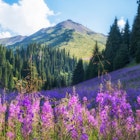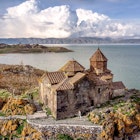
Crossing Kazakhstan by train - a two week journey through a bygone era

Jul 30, 2024 ŌĆó 7 min read

On long train journeys across the steppes of Kazakhstan, travelers find a sense of community and connection ┬® Juan Martinez
A place once inaccessible, even secluded, Kazakhstan today welcomes intrepid travelers with open arms.
This Central Asian country offers a captivating mix of Silk Road traditions, intriguing remnants of the Soviet era and landscapes that stretch out almost endlessly.
I headed to KazakhstanŌĆÖs steppes to find out more about a region unfamiliar to many travelers. Fascinated by the history of and nostalgia for ex-Soviet railways, I embarked on a two-week train journey across the country. With several stops along the way, I took seven different trains from Astana (now called Nur-Sultan) in the cold north to ancient Turkestan in the warm south. On these long rides, I took a journey through a bygone era. On these Soviet-era trains, with their particular blend of the antique and the comfortable, time seemed to slow down ŌĆō and the allure of the unknown beckoned.

On board, I found no crowds of young backpackers with inter-rail tickets or businessmen hunched over laptops. Instead, I encountered a sense of community and connections. Strangers were constantly chatting with each other, families set up portable kitchens to cook warm soups and local dumplings (manti) in their compartments, and men played cards while enjoying a beer.
As the sun set, the atmosphere of the train completely transformed. Seats folded into cozy beds as each wagon became a little home. Some passengers prepared kettles of tea to share with anyone who struck up a conversation, while others built blanket forts to create more privacy. Although I was not able to communicate a single word with fellow travelers most of the time, we ended up understanding each other through hand gestures or shared knowledge of popular culture.
Crossing the biggest landlocked country in the world
My journey began in KazakhstanŌĆÖs capital, Astana. Here, I planned my itinerary, which involved hopping on and off high-speed trains to the cities of Almaty and later Turkestan. I spent a few days exploring each of these citiesŌĆÖ attractions, and also went on day trips to nearby destinations, using regional trains or shared taxis as convenient modes of transportation.
offers many options for travelers. The 1200km (745-mile) journey between the countryŌĆÖs largest cities can be covered in just over 15 hours by fast trains (starting at Ōé¼40), while regional trains provide a slower but cheaper option, with the 24-hour trip starting at just Ōé¼15. Accommodation ranges from dormitory-style cabins to more private four-berth or two-berth cabins.

Days 1 to 3: Astana
My time in Astana was short but essential for my trip. Here, I organized my journey and got a glimpse of what lay ahead. Unfortunately, the cityŌĆÖs harsh weather limited my exploration: heavy snowfalls and freezing temperatures persisted into May.
I did manage a short excursion to Burabay National Nature Park, a paradise of lakes and forests three hours away by train. (Tickets are Ōé¼5 each way; I recommend booking tickets in advance due to limited availability.) This trip also introduced me to the bustling and lively atmosphere of the open wagon, adding a touch of excitement to the journey.
Karaganda, a city two hours south of Astana, was another potential stop. Yet I decided to skip it after locals advised that it primarily appeals to those interested in the USSRŌĆÖs industrial era and have more time to explore.

Days 4 to 10: Almaty
From Astana, I embarked on the 15-hour overnight journey to the city of Almaty aboard the fastest train in Kazakhstan, the Talgo. To ensure a more comfortable night ride, I reserved a seat in a four-berth wagon for Ōé¼37 a few days prior to departure. I came prepared with plenty of snacks for dinner and breakfast, only to discover that the restaurant car offered a fantastic menu at very affordable prices.
In Almaty, I learned that I could easily arrange day trips to explore the stunning natural landscapes of southern Kazakhstan through shared taxis and local tour companies.
With a diverse range of outdoor destinations and day getaways, Almaty became my primary base during my time in Kazakhstan. The cityŌĆÖs unique blend of Soviet charm and surprising hipster vibes was incredibly appealing, enticing me to further explore not only its surroundings but also AlmatyŌĆÖs trendy cafes and cool bars.

Days 11 to 14: Turkestan
I hopped on another fast train to reach Turkestan, a journey of 12 hours. Opting for a VIP two-berth compartment with a private bathroom and booking both seats for just myself (Ōé¼52 total), I ensured a comfortable and luxurious ride that was totally worth its high cost.
With warm temperatures, blue skies and ancient Islamic architecture that made me forget I was in the former Soviet Union, Turkestan offered a stark contrast from what I had seen elsewhere in Kazakhstan. The highlight was the stunning Yasaui Mausoleum, with its blue dome and over seven centuries of history. I also took a day trip via regional train (Ōé¼4 for three hours of travel) to Shymkent, where I explored the bazaar and found out why locals say this town has the best food in the country.
Although my Kazakhstan adventure concluded here, I couldnŌĆÖt help but imagine the possibilities of traveling even farther in this vast country. With more time at hand, I could have gone for a 25-hour train ride all the way to the westernmost city of Aktau on the Caspian Sea (tickets from Ōé¼43). Alternatively, I could have gone on a full round trip, returning to my starting point in Astana and claiming to have traveled in a circle across the largest landlocked country in the world.

How to plan a rail journey in Kazakhstan
The best times to visit: AprilŌĆōMay and SeptemberŌĆōOctober
The weather during these transitional seasons provides a pleasant balance between warm and cool temperatures, enabling more exploration of KazakhstanŌĆÖs landscapes. When I traveled in early May, I encountered a variety of temperatures, ranging from as low as 2┬░C (36┬░F) in the northern regions to as high as 30┬░C (86┬░F) in the south.
How to research train routes
Kazakhstan has an extensive railway network connecting major cities and scenic destinations. Identify the key destinations you wish to visit ( is a big help with that), then determine the train connections between them. Take into account the duration of the journeys, train schedules and the availability of sleeper or express trains for longer trips. I researched my routes at .
How to book tickets
Once you know where you want to go and when, you can make reservations online through the , the national railway company. Since the interface for non-Russian speakers is extremely buggy, however, with most credit cards getting declined, I bought my tickets through Tickets.kz, which accepts foreign cards, offers refunds if necessary and delivers tickets electronically. On the ground in Kazakhstan, you can book tickets in person at local train stations or authorized travel agencies. However you book, you should do so well ahead of time to secure your preferred travel dates and class of service.
Classes of service on trains in Kazakhstan
Kazakh trains offer classes of service ranging from economy to luxury. Regional trains provide comfortable seating in economy class, while sleeper cabins offer berths for overnight journeys. Most long-distance trains offer a standard Soviet-era platzkart (open wagon), Kupe (four-berth wagon) and SV/Lyux (two-berth wagon). Talgo trains also offer a VIP version of the SV/Lyux, which includes an en-suite bathroom and shower.
For daytime rides, I recommend booking an open wagon to interact with the locals. For overnight connections, having your own bed and private space can be invaluable.

Build flexibility into any itinerary
When planning your train trip, allow for some flexibility in your itinerary, since trains in Kazakhstan may occasionally experience delays or schedule changes. This is especially useful for long-distance rides, as my ride from Almaty to Turkestan was delayed for over two hours.
Cultural considerations on trains in Kazakhstan
Familiarize yourself with local customs and etiquette. While on the train, respect the personal space of fellow passengers and follow any guidelines or instructions provided by the train staff. Each compartment has its own train controller, who will have a list with each booked seat on the wagon. Even though there is a good chance they wonŌĆÖt speak English, they are usually friendly to talk to. You can try to communicate using a Russian-English translation app ŌĆō it helped me more than you think.
Explore related stories

Sustainable Travel
Making a Silk Road journey through Uzbekistan entirely by trainJul 18, 2023 ŌĆó 5 min read






 Destination PracticalitiesEverything you need to know about your first trip to Kyrgyzstan
Destination PracticalitiesEverything you need to know about your first trip to KyrgyzstanMay 24, 2024 ŌĆó 7 min read
 Historic SiteA Total Trip: What I spent on an ambitious six-day group tour across Uzbekistan
Historic SiteA Total Trip: What I spent on an ambitious six-day group tour across UzbekistanSep 14, 2023 ŌĆó 9 min read

